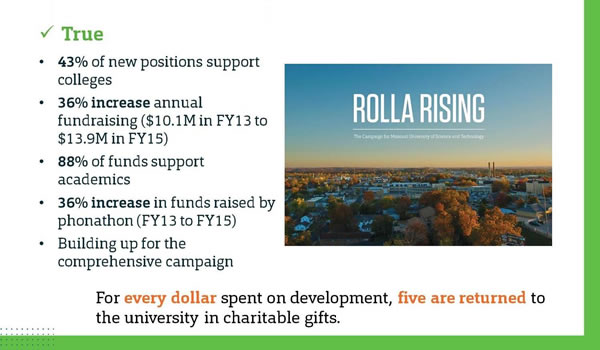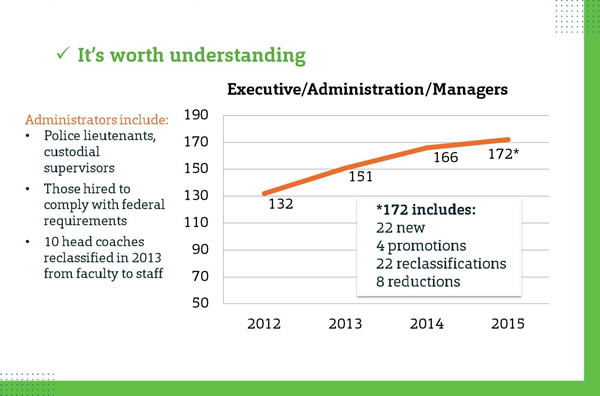Have you heard ...

During the past several years, Missouri S&T has transformed from a small university to a larger, increasingly complex institution. As our university changes, so does our need to communicate more effectively. This page offers another avenue for members of the Missouri S&T community to learn about current initiatives and inquire about topics of interest.
Have You Heard items can be submitted here. Questions and comments may be submitted anonymously. Providing your contact information will ensure a direct response and might be helpful if more information is needed to better understand your inquiry. Check this site often as reponses to submissions of a general nature may be posted.
- Faculty Hiring
- Faculty Salaries
- University Advancement Growth
- Administrative Growth
Faculty Hiring
 Where we are in adding faculty? (Posted April 2016)
Where we are in adding faculty? (Posted April 2016)
Missouri S&T has added 26 additional faculty to our ranks through the faculty hiring initiative in the strategic plan. By the end of the year, the university expects to be over 40.
However, when look you at the numbers, it can be confusing, especially because there are so many ways to look at the data. Are you doing a headcount in Peoplesoft? Do you count the number of faculty lines? Do you count adjuncts?
This chart shows our steady growth since 2012. You'll notice that while 26 faculty have been added since 2012 (as a result of our strategic hiring initiative), our total growth is even higher. Those additional hires represent the filling of vacancies, which ebb and flow from year to year.
Note, the 2012 total does not include 10 head coaches, who used to be classified as faculty but are now counted as staff. The 2016 number is an estimate that includes current searches.
Through the faculty hiring initiative, our faculty ranks will continue to grow.
Bottom line: Yes, we are increasing the number of faculty on this campus. And we are doing this strategically.
Faculty Salaries
 Are we gaining ground on faculty salaries? (Posted April 2016)
Are we gaining ground on faculty salaries? (Posted April 2016)
We are gaining ground.
This chart shows faculty salaries at each University of Missouri System Campus plotted against the median salary of their peer institutions. Missouri S&T is represented by the gold line.
In this illustration, being lower means that an institution is closer to its peer median. Since 2012, the university has moved from 16 percent below peer median to less than 10 percent. It should be noted that as a technological research university, our peer group includes some very well-endowed private institutions and highly funded public institutions. Also, many of our peer institutions are on the coasts.
The university is investing in faculty salaries through bigger promotional bumps at all points, and through post-tenure rewards. Last year alone, the university invested 2.8 percent more in faculty salaries through merit increases, promotional salary increases, mid-year retention increases, post-tenure adjustments, and external awards and recognition increases.
Bottom line: Missouri S&T is closing the gap, and we are doing so rapidly.
University Advancement Growth
 I've heard ... University Advancement has grown 70% in the past few years. (Posted April 2016)
I've heard ... University Advancement has grown 70% in the past few years. (Posted April 2016)
This is correct. In 2014, in anticipation of launching a comprehensive campaign and embarking on a branding initiative, a significant investment in University Advancement was needed to make both efforts possible and successful. Since 2012, the division’s budget has increased 70 percent, from $2.66 million to $4.52 million.
Since 2012, 14 positions were approved for advancement and six of them provide dedicated support to the new colleges. They are: two senior development officers, two senior communications consultants and two user interface web designers.
There is a significant ROI factor driving this investment. For example, annual fundraising has increased more than 36 percent in the past two years, from $10.1 million in FY13 to $13.9 million in FY15. Of the total raised, nearly 90 percent supported academic enterprises. We are seeing significant increases in donor renewal, gift officer visits and giving to new funding initiatives such as crowdfunding. Phonathon, to provide another example, raised 36 percent more in 2015 than 2013. These funds are primarily unrestricted dollars given to academic departments.
During the same time, University Advancement completed the first comprehensive market research study since the university name change in 2008 and launched a refined brand identity for the campus, which is reflected in our website, the stories we tell about Missouri S&T, and marketing and communications materials.
Finally, for every dollar spent on development, five are returned to the university in gifts, 90 percent of which go into academics.
Bottom line: Yes, this division has increased in recent years, and the university has very high expectations for what this investment will continue to yield.
Administrative Growth
 I've heard ... concern about administrative growth. (Posted April 2016)
I've heard ... concern about administrative growth. (Posted April 2016)
In the past few years, Missouri S&T has experienced growth in this area, and it's worth understanding why. This growth is driven in part by reclassifying some workers, increasing demands to comply with federal requirements and our strategic restructuring of the university.
It’s important to note that not all these positions are new. Some positions are existing staff who were reclassified or promoted. This group includes individuals one might not think of as “administrators,” including police lieutenants and custodial supervisors. Individuals at both the director and manager level can be considered “administration.” In addition, while some departments gained administrators, some also reduced them, such as the provost’s office and undergraduate studies. In total, the 2015 figure represents 22 new positions, 4 promotions, 22 reclassifications and 8 reductions.
Of those added as administrators since 2012:
- One quarter are head coaches, formerly categorized as faculty (change made in 2013)
- One quarter are in student affairs and human resources, most of whom were required to help us meet federal regulatory standards related to Title IX
- 11 are in University Advancement (See University Advancement Growth tab)
Finally, some of this growth is due to the necessary infrastructure to enable our strategic restructuring with the two colleges, Global and Strategic Partnerships, and Finance and Administration.
So, yes, the number of “administrators” has increased, and it makes sense to understand what this represents.
